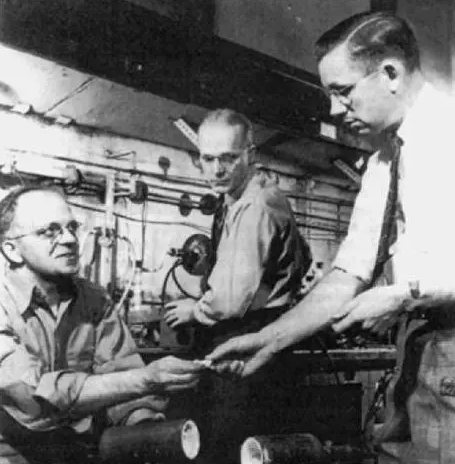PTFE, notoriously called Teflon, was not a planned exploration. In 1938, DuPont stumbled upon this remarkable material quite by crash, stimulating a transformation in materials scientific research and industrial applications.
One morning in 1938, Roy Plunkett, a young drug store, was busy playing with his experiments behind-the-scenes of DuPont. His job seemed easy: discover a new cooling agent.
(Roy and his colleagues)
Nevertheless, just when Roy assumed it was simply a regular job, things deviated. He kept the tetrafluoroethylene gas in a cyndrical tube and said to himself: “Okay, see you tomorrow.” The following day, when he went back to proceed his experiment, he discovered that the gas had actually mysteriously vanished, leaving only a stack of white powder. Well, this was definitely various from the script he planned. Envision his expression during that time: half confused, half interested. Upon more examination, he found that this unusual white powder had some cool superpowers: it was hostile to almost all chemicals, could stay great at severe temperature levels, and was as slippery as oil. Unexpectedly, Luo understood that while he had yet to find a brand-new refrigerant, he had actually mistakenly found the secret component of the kitchen superhero of the future – non-stick frying pans. After that, frying eggs was no more a difficulty, and cleaning pots ended up being a breeze.
Although the exploration of PTFE was unexpected, it had big revolutionary significance for the plastics sector and lots of various other areas, such as aerospace, automobiles, electronic devices, and home appliances. PTFE is widely utilized due to its unique chemical and physical homes – exceptionally low rubbing coefficient, high-temperature resistance, chemical stability, and non-stickiness. From kitchen utensils to integral parts of the space shuttle, PTFE made several ingenious applications possible. Yet while PTFE (Teflon ┬«) noted a cutting edge development in products science, it was just the start of a lengthy and tough roadway to commercialization and prevalent application. The first challenge was not just to discover a brand-new material but also to find out exactly how to achieve large production and how to apply it in different areas.
The procedures of monomer synthesis and regulated polymerization of PTFE were not fully developed, making it challenging to generate PTFE in big quantities or a feasible way. While the product’s one-of-a-kind residential or commercial properties were valuable in the long run application, they additionally postured significant difficulties during the manufacturing procedure. Unlike various other regular plastics, PTFE is not soluble in solvents, acids, or bases and does not melt into a flowable liquid. Instead, when warmed, it comes to be a hard, clear gel that does not thaw and streams like plastics.
(Roy’s Notes: Discovery of PTFE)
To overcome these obstacles, researchers and designers battled to find procedures from other fields, such as adapting techniques from steel and ceramic handling. To shape PTFE, a procedure called paste extrusion was made use of, which was obtained from ceramic processing. Although traditional molding and developing methods had some trouble refining PTFE, it was feasible to produce PTFE components. By 1947, comprehensive research and experimentation had thrived, and a small production facility was established in Arlington, New Jersey. This noted the beginning of Teflon ┬«’s journey from the laboratory to the market. In 1950, DuPont opened a brand-new plant in Parkersburg, West Virginia, considerably increasing the industrial manufacturing of Teflon ┬«. That exact same year, the technology went across the Atlantic when Imperial Chemical Industries constructed the very first PTFE plant outside the USA in the UK.
Supplier of PTFE Powder
TRUNNANO is a supplier of 3D Printing Materials with over 12 years experience in nano-building energy conservation and nanotechnology development. It accepts payment via Credit Card, T/T, West Union and Paypal. Trunnano will ship the goods to customers overseas through FedEx, DHL, by air, or by sea. If you want to know more about hpmc applications, please feel free to contact us and send an inquiry.
Inquiry us

